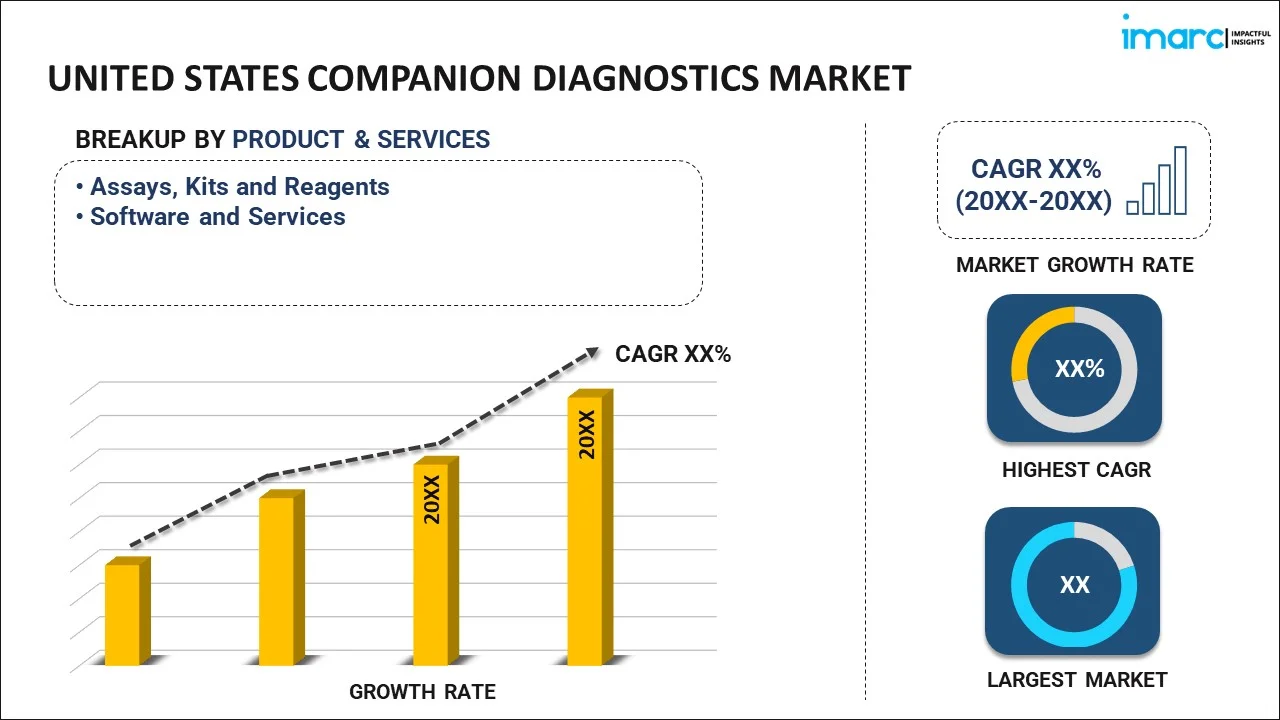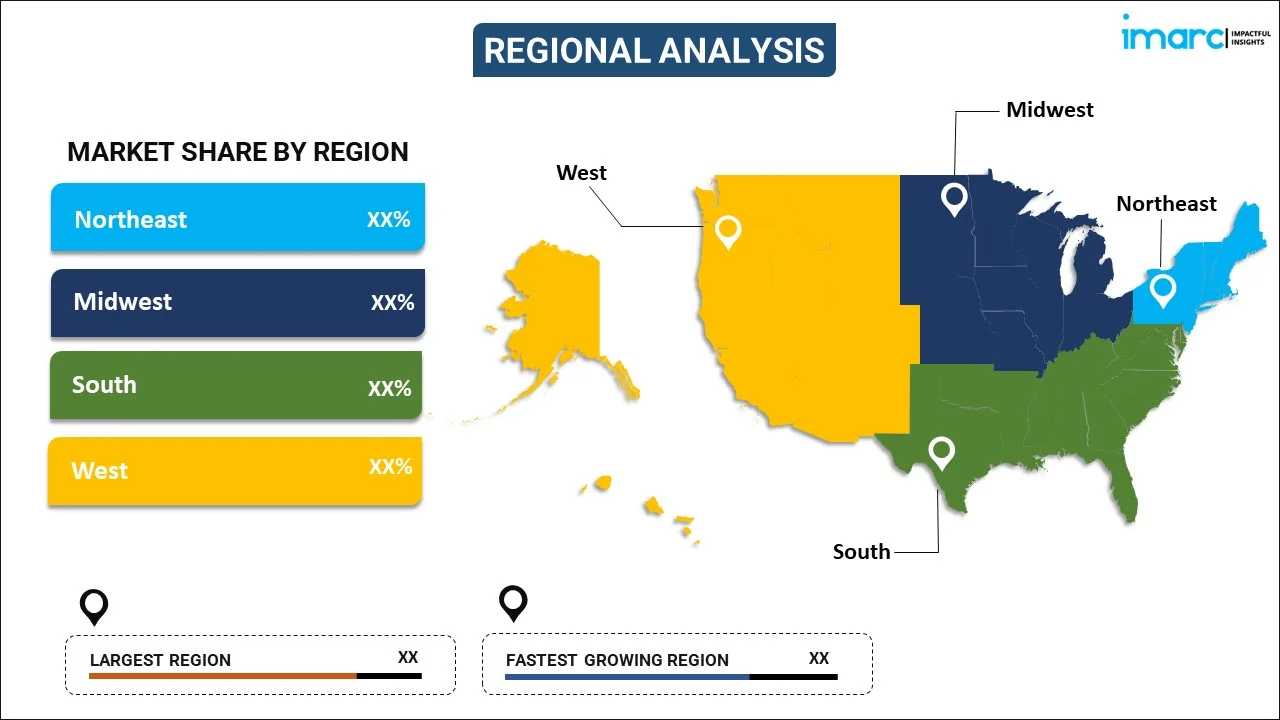
United States Companion Diagnostics Market Report by Product & Service (Assays, Kits and Reagents, Software and Services), Technology (Immunohistochemistry (IHC), Polymerase Chain Reaction (PCR), In-situ Hybridization (ISH), Real-time PCR (RT-PCR), Gene Sequencing, and Others), Indication (Cancer, Neurological Diseases, Infectious Diseases, Cardiovascular Diseases, and Others), End User (Pharmaceutical & Biopharmaceutical Companies, Reference Laboratories, Contract Research Organizations, and Others), and Region 2025-2033
Market Overview:
The United States companion diagnostics market size reached USD 2.4 Billion in 2024. Looking forward, IMARC Group expects the market to reach USD 5.8 Billion by 2033, exhibiting a growth rate (CAGR) of 10.3% during 2025-2033. The rising prevalence of chronic diseases, ongoing technological advancements in personalized medicine, and strong regulatory support across the country fostering significant growth in precision healthcare and targeted therapeutic approaches represent some of the key factors driving the market.
|
Report Attribute
|
Key Statistics
|
|---|---|
|
Base Year
|
2024
|
|
Forecast Years
|
2025-2033
|
|
Historical Years
|
2019-2024
|
|
Market Size in 2024
|
USD 2.4 Billion |
|
Market Forecast in 2033
|
USD 5.8 Billion |
| Market Growth Rate 2025-2033 | 10.3% |
Companion diagnostics are medical devices, often assays or tests, designed to assist healthcare professionals in determining whether a particular treatment or therapeutic product is appropriate for a patient. They help evaluate the patient's biomarkers, genetic makeup, or other specific characteristics to ascertain the suitability and potential effectiveness of a specific drug therapy. The utilization of companion diagnostics is transformative in oncology and various other medical specialties, enabling more personalized treatment approaches. By identifying patients most likely to benefit from a particular treatment, these diagnostics enhance treatment efficacy and reduce the likelihood of adverse reactions. They also support drug development by identifying target patient populations, thereby streamlining clinical trials and aiding in the development of more targeted therapies. The integration of companion diagnostics in healthcare aligns with the evolving landscape of personalized medicine, where treatments are increasingly tailored to individual patient profiles. This approach improves patient outcomes and contributes to the greater efficiency and cost-effectiveness of healthcare systems. Presently, companion diagnostics are gaining prominence in the field of precision medicine, and its scope and application are expected to expand as research progresses, further revolutionizing patient care and treatment methodologies.
United States Companion Diagnostics Market Trends:
The United States companion diagnostics market is experiencing significant growth, driven by a confluence of factors that reflect both technological advancements and evolving healthcare paradigms. One of the primary drivers is the growing prevalence of chronic diseases, particularly cancer, where companion diagnostics play a crucial role in personalized treatment. This rise in chronic conditions necessitates more efficient and targeted therapeutic approaches, fueling the demand for companion diagnostics. Besides this, technological innovations, such as continuous advances in genomics and biotechnology, have enabled the development of more sophisticated companion diagnostics, offering precise insights into patient-specific disease mechanisms. This technological leap enhances the efficacy of personalized treatments, thereby accelerating the adoption of companion diagnostics. Additionally, the pharmaceutical industry's shift toward precision medicine represents a major growth-inducing factor as drug developers are increasingly focusing on creating targeted therapies, often in conjunction with companion diagnostics, to ensure optimal patient outcomes. This synergy between drug development and diagnostics is pivotal in propelling market growth. Furthermore, the increasing regulatory support from bodies like the FDA's endorsement and streamlined approval processes for companion diagnostics, especially those targeting unmet medical needs, is fostering innovation and investment in this sector. In line with this, the growing awareness among healthcare providers and patients about the benefits of personalized medicine is catalyzing the demand for companion diagnostics. As healthcare shifts toward value-based care, the focus on achieving better patient outcomes at lower costs aligns well with the capabilities of companion diagnostics. Moreover, the increasing collaborations and partnerships among diagnostic companies and pharmaceutical firms are leading to the development of more integrated and effective diagnostic solutions, overcoming technical and regulatory challenges and thereby supporting market growth. Along with this, the rising healthcare expenditure in the United States, coupled with favorable reimbursement policies for advanced diagnostic tests, has spurred the adoption of companion diagnostics, positively influencing market growth.
United States Companion Diagnostics Market Segmentation:
IMARC Group provides an analysis of the key trends in each segment of the market, along with forecasts at the country level for 2025-2033. Our report has categorized the market based on product & service, technology, indication, and end user.
Product & Service Insights:

- Assays, Kits and Reagents
- Software and Services
The report has provided a detailed breakup and analysis of the market based on the product & service. This includes assays, kits and reagents and software and services.
Technology Insights:
- Immunohistochemistry (IHC)
- Polymerase Chain Reaction (PCR)
- In-situ Hybridization (ISH)
- Real-time PCR (RT-PCR)
- Gene Sequencing
- Others
A detailed breakup and analysis of the market based on technology have also been provided in the report. This includes immunohistochemistry (IHC), polymerase chain reaction (PCR), in-situ hybridization (ISH), real-time PCR (RT-PCR), gene sequencing, and others.
Indication Insights:
- Cancer
- Lung Cancer
- Breast Cancer
- Colorectal Cancer
- Gastric Cancer
- Melanoma
- Others
- Neurological Diseases
- Infectious Diseases
- Cardiovascular Diseases
- Others
The report has provided a detailed breakup and analysis of the market based on the indication. This includes cancer (lung cancer, breast cancer, colorectal cancer, gastric cancer, melanoma, and others), neurological diseases, infectious diseases, cardiovascular diseases, and others.
End User Insights:
- Pharmaceutical & Biopharmaceutical Companies
- Reference Laboratories
- Contract Research Organizations
- Others
A detailed breakup and analysis of the market based on end users have also been provided in the report. This includes pharmaceutical & biopharmaceutical companies, reference laboratories, contract research organizations, and others.
Regional Insights:

- Northeast
- Midwest
- South
- West
The report has also provided a comprehensive analysis of all the major regional markets, which include the Northeast, Midwest, South, and West.
Competitive Landscape:
The market research report has also provided a comprehensive analysis of the competitive landscape in the market. Competitive analysis such as market structure, key player positioning, top winning strategies, competitive dashboard, and company evaluation quadrant has been covered in the report. Also, detailed profiles of all major companies have been provided.
United States Companion Diagnostics Market Report Coverage:
| Report Features | Details |
|---|---|
| Base Year of the Analysis | 2024 |
| Historical Period | 2019-2024 |
| Forecast Period | 2025-2033 |
| Units | Billion USD |
| Scope of the Report | Exploration of Historical Trends and Market Outlook, Industry Catalysts and Challenges, Segment-Wise Historical and Future Market Assessment:
|
| Product & Services Covered | Assays, Kits and Reagents, Software and Services |
| Technologies Covered | Immunohistochemistry (IHC), Polymerase Chain Reaction (PCR), In-situ Hybridization (ISH), Real-time PCR (RT-PCR), Gene Sequencing, Others |
| Indications Covered |
|
| End Users Covered | Pharmaceutical & Biopharmaceutical Companies, Reference Laboratories, Contract Research Organizations, Others |
| Regions Covered | Northeast, Midwest, South, West |
| Customization Scope | 10% Free Customization |
| Post-Sale Analyst Support | 10-12 Weeks |
| Delivery Format | PDF and Excel through Email (We can also provide the editable version of the report in PPT/Word format on special request) |
Key Questions Answered in This Report:
- How has the United States companion diagnostics market performed so far and how will it perform in the coming years?
- What has been the impact of COVID-19 on the United States companion diagnostics market?
- What is the breakup of the United States companion diagnostics market on the basis of product & service?
- What is the breakup of the United States companion diagnostics market on the basis of technology?
- What is the breakup of the United States companion diagnostics market on the basis of indication?
- What is the breakup of the United States companion diagnostics market on the basis of end user?
- What are the various stages in the value chain of the United States companion diagnostics market?
- What are the key driving factors and challenges in the United States companion diagnostics?
- What is the structure of the United States companion diagnostics market and who are the key players?
- What is the degree of competition in the United States companion diagnostics market?
Key Benefits for Stakeholders:
- IMARC’s industry report offers a comprehensive quantitative analysis of various market segments, historical and current market trends, market forecasts, and dynamics of the United States companion diagnostics market from 2019-2033.
- The research report provides the latest information on the market drivers, challenges, and opportunities in the United States companion diagnostics market.
- Porter's five forces analysis assist stakeholders in assessing the impact of new entrants, competitive rivalry, supplier power, buyer power, and the threat of substitution. It helps stakeholders to analyze the level of competition within the United States companion diagnostics industry and its attractiveness.
- A competitive landscape allows stakeholders to understand their competitive environment and provides an insight into the current positions of key players in the market.
Need more help?
- Speak to our experienced analysts for insights on the current market scenarios.
- Include additional segments and countries to customize the report as per your requirement.
- Gain an unparalleled competitive advantage in your domain by understanding how to utilize the report and positively impacting your operations and revenue.
- For further assistance, please connect with our analysts.
 Request Customization
Request Customization
 Speak to an Analyst
Speak to an Analyst
 Request Brochure
Request Brochure
 Inquire Before Buying
Inquire Before Buying




.webp)




.webp)












